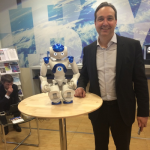About cookies on this site Our websites require some cookies to function properly (required). In addition, other cookies may be used with your consent to analyze site usage, improve the user experience and for advertising. For more information, please review your options. By visiting our website, you agree to our processing of information as described in IBM’sprivacy statement. To provide a smooth navigation, your cookie preferences will be shared across the IBM web domains listed here.
Perspectives
Why it makes sense to start your AI journey in the IBM Garage.
29 August, 2019 | Written by: Francesco Brenna
Categorized: Perspectives
Share this post:
A surprising statistic from a recent report, picked up by Forbes and others in March, suggested that 40 percent of European firms calling themselves “AI start-ups” are not, in fact, deploying AI technology at all. The implication seems to be that hype around AI is just that: hype.
My experience, though, is that established businesses throughout Europe are excited – even bullish – about the possibilities that advanced analytics and AI have to offer. But they’re often unsure about how to find the right use cases for the technology and, in particular, how to scale it across their enterprise. Fortunately, IBM Services has created a methodology – and an environment – specifically designed to de-risk innovation and rapidly scale the best ideas. Enter the IBM Garage.
The IBM Garage is a co-creation experience that combines deep collaboration with agile and design thinking methods to address specific business challenges. Clients and IBMers come together in a dedicated co-innovation space and work in short sprints to build minimum viable products (MVPs) that embody specific advances, safe in the knowledge that a foundation of IBM technology and expertise means the most promising MVPs can be readily developed and deployed at scale. It’s an approach that’s proving popular across the spectrum of digital transformation.
When it comes to AI, the challenge for businesses is twofold. First, they need to identify where AI could have an impact, and then they need to be sure they can institutionalise the skills and resources needed to embrace AI in the longer term. The garage offers a path for both these challenges. The path itself, though, may have one of two different starting points.
Some businesses come to us with a specific business challenge in mind. Perhaps, as with Vodafone in Europe, they need to increase efficiency in call centres. In a sense, this is a traditional IBM Services consultative engagement, but by tackling a challenge such as this in the IBM Garage, it is possible to bring specific collaborative focus to the challenge and begin to bring about a cultural shift in the way the business thinks about innovation. More often than not, that first garage will trigger a series of further similar engagements that together add up to a long-term framework for AI-driven digital transformation.
Other organisations are more aligned to garage-style innovation in the first place. They are less interested in solving a particular problem and more focused on ways that AI can drive innovation more generally. There are fewer clients in this category at the moment, but it’s interesting and hugely rewarding to set out with a broader agenda to seek out opportunities for change.
The risk, in these scenarios, can be trying to be too blue sky in your thinking. In my experience, embarking from scratch on truly open-ended innovation tends to get no further than a series of proofs of concept which have no solid business cases and little chance of making it into scalable production.
In the garage, however, we make sure we bring some building blocks to the table in the form of existing use cases and other ideas that might accelerate innovation. So even if we are setting out on a broad challenge to use AI to drive innovation, we know we have some components up our sleeves that may prove relevant and will certainly scale into production.
A case in point is our work with French bank Credit Mutuèl. Three years ago, they came to us looking to drive innovation throughout the organisation. The first output of our garage engagement was some use cases for in-branch consultants that ultimately manifested as a series of virtual advisers that we deployed and iteratively developed over a number of months. As a result, the bank saw the value of the approach and we introduced AI and automation to several other domains, for instance improving the efficiency of email channels. Having started small, we’re now running an ongoing garage engagement of around 100 people, from IBM and Credit Mutuèl, focusing on both innovation and agile deployment.
In a relatively short space of time, the IBM Garage has gone from being a door-opener for our AI consultancy practice to being our standard model for engagement. And we also use exactly the same methods behind the scenes, setting up virtual agile teams among our 600 data scientists across Europe to develop new use cases and building blocks for future engagements.
So in a way we’ve used the IBM Garage to build our AI business around the IBM Garage. There’s no hype to see here.

Francesco Brenna
Executive Partner, AI & Analytics Leader, IBM Services Europe
More stories
By Helen Gowler on 3 October, 2024
Generative AI: driving a new era of HR transformation
Helen Gowler, Partner, EMEA Talent & Transformation Lead Today, I’m proud to be part of a company that’s committed to addressing gender bias in the tech industry. IBM is pioneering the use of AI to tackle this issue, and I’m excited to contribute to this effort. Our team is developing AI models that can detect […]
By Mark Restall on 18 July, 2024
Multi-Modal Intelligence Platform
Traditionally, data management systems provided only numerical or textual based business intelligence primarily for back-office users across finance, sales, customer management and supply chain. Today, we are increasingly seeing data management systems which drive key business functions requiring interrogation of multi-modal data sets from documents, presentations, images, videos to audio. This demands a more sophisticated […]
By Mark Restall and others on 16 July, 2024
The use of GenAI to Migrate and Modernise Organisational Core Programming Languages
GenAI is hugely powerful and supports a diversity of use cases by focusing on routine work – allowing people to focus time on value-add tasks, thus enhancing productivity. The focus of this use case is for an organisation which had previously focussed on a legacy set of tooling and programming languages and needed a way […]





























